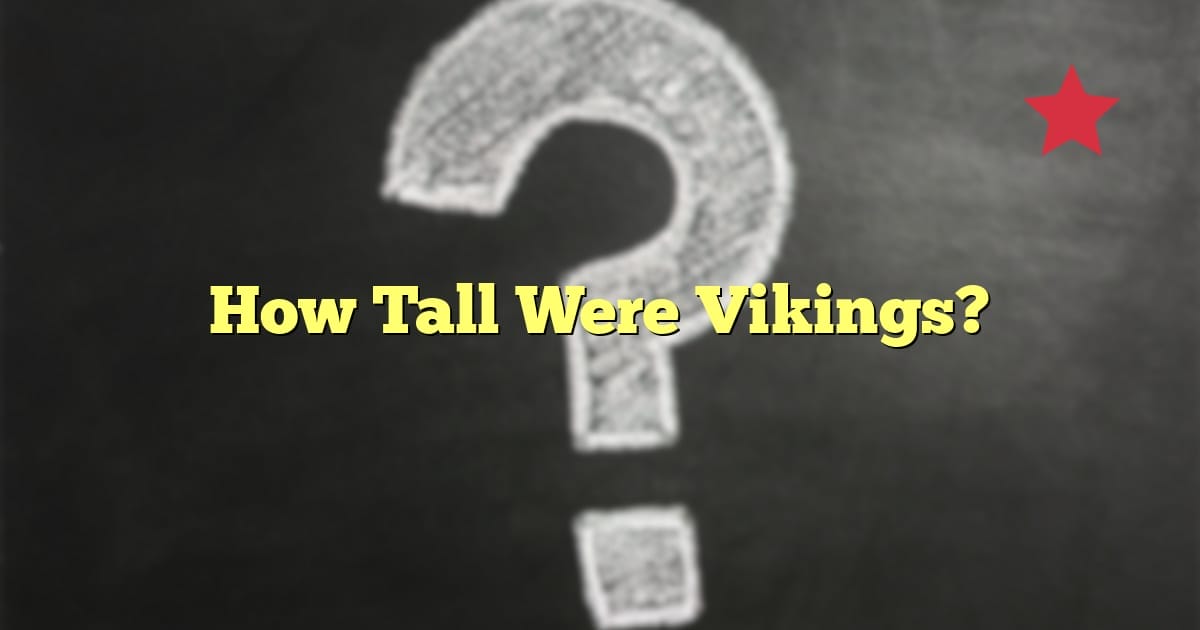How Tall Were Vikings?

When it comes to the height of Vikings, there are many myths and misconceptions. In this article, we will delve into the facts surrounding the average height of Viking men and women and explore the various factors that influenced their stature.
Contrary to popular belief, Vikings were not significantly taller than other Europeans of their time. The average height of a Viking male was about 173 cm (5 feet 7 inches), while Viking women typically stood around 157 cm (5 feet 2 inches). This puts them in line with the average height of their European counterparts.
Researchers at Ohio State University conducted a study on Viking skeletons and found that during the Early Middle Ages, Viking men had an average height of around 173.4 centimeters. This suggests that Vikings were indeed taller than people from earlier periods but fell short of modern human heights.
Several factors played a role in determining the height of Vikings. The Viking diet, which consisted of nutrient-rich foods such as fresh fish, meat, and crops from their cultivated fields, contributed to their optimal growth. Their physically active lifestyle, encompassing activities like sailing, farming, and raids, also influenced their height. Physical activity has been known to stimulate height growth.
The sheltered environment provided by the snug Viking longhouses offered warmth and protection, creating conditions that were conducive to better physical development. The stability and safety within Viking communities allowed their children to grow without constant threats or disruptions.
Factors Influencing Viking Height (Diet, Lifestyle, and Environment)
The height of Vikings was influenced by various factors, including their diet, lifestyle, and environment. These factors played a crucial role in determining their optimal growth and stature.
Their diet was rich in nutrients that contributed to their height. They consumed fresh fish, meat, and crops from their well-tended fields, providing them with essential proteins and vitamins necessary for proper growth.
The active lifestyle of Vikings also played a significant role in their height. Engaging in activities such as sailing, farming, and raids not only kept them physically fit but also stimulated their height growth.
The Viking longhouses, known for their snugness, provided warmth and protection to the inhabitants. This sheltered environment created favorable conditions for better physical development, contributing to their overall height.
The Nordic climate, though challenging, indirectly supported the stature of Vikings. The cold climate pushed them to consume more calories, ensuring they had sufficient energy for their physically demanding lifestyle.
Environmental shifts, such as warm spells leading to more abundant crops, also played a role in Viking height. These shifts provided better nutrition, allowing Viking children to grow without constant threats or disruptions.
The factors influencing Viking height include their nutrient-rich diet, physical activity, sheltered environment, stability, safety, and the impact of the Nordic climate. These factors collectively contributed to the height of Vikings, allowing them to thrive in their demanding world.
Viking Height in Context (Comparisons and Historical Perspectives)
| Group | Average Height (Men) | Average Height (Women) |
|---|---|---|
| Vikings | 173 cm (5 feet 7 inches) | 157 cm (5 feet 2 inches) |
| Anglo-Saxons | Slightly shorter than Vikings | Slightly shorter than Viking women |
Vikings were taller than the average European during their time, but they were not giants as often depicted in popular culture. According to average height measurements, Viking men stood at around 173 cm (5 feet 7 inches), while Viking women were typically around 157 cm (5 feet 2 inches) tall. In comparison, the Anglo-Saxons, their contemporaries, were slightly shorter on average.
Genetic factors, along with nutrition, healthcare, shelter, and safety, all contributed to the stature of the Vikings. Recent Viking DNA studies have shed light on their physical appearance and debunked the myth of their towering height.
While Vikings may not have been as tall as their modern Scandinavian descendants, they were taller than people in earlier periods and some of the communities that followed.
The Norse sagas, historical accounts from the Viking Age, sometimes mention exceptional individuals who were described as giants due to their extraordinary strength and size. These accounts highlight the reputation of Viking strength and muscle mass.
Archaeological evidence also supports their physical prowess, showcasing their robust build and physical capabilities.

